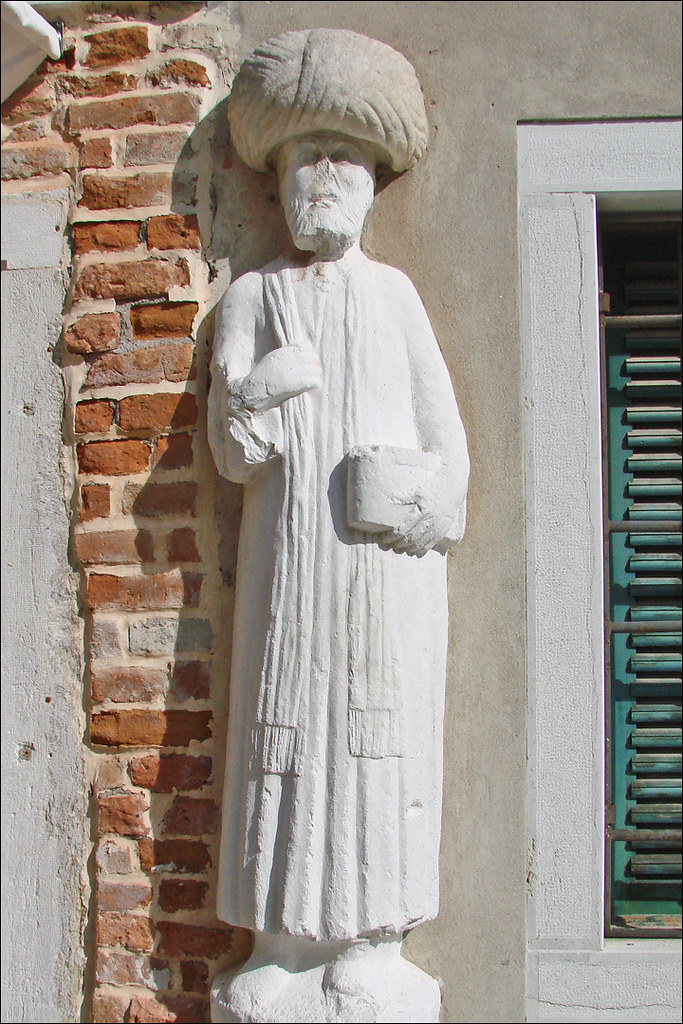 |
| Fonte foto: http://venezia-giorno-per-giorno.blogspot.it/ |
Questa leggenda di Venezia è ambientata nel Sestiere di Canareggio, ed in particolare in Campo dei Mori dove troverete Palazzo Mastelli del Cammello, il cui nome “del Cammello” deriva da un bassorilievo in pietra in cui viene raffigurato un uomo vestito con abiti orientali, un Moro dunque, come lo si soleva chiamare in quell’epoca, che tiene le redini di un cammello.
Lungo le mura di questo palazzo troverete 4 statue di pietra incastonate nel muro, sono proprio loro i protagonisti della nostra storia.
 |
| Afani - Rioba's brother - © Dalbera |
Giunti a Venezia i tre fratelli, con il loro servitore, si fecero chiamare “Mastelli” o “Mastella” da cui poi prese il nome il palazzo. Erano abili mercanti di stoffe, ma anche dei bricconi e truffaldini e non si tiravano indietro dall’ingannare e truffare per denaro coloro che si rivolgevano a loro.
Stanca del loro comportamento, Santa Maria Maddalena decise di punirli e così nelle vesti di una nobile vedova di un mercante veneziano, un giorno si recò dai tre fratelli per acquistare da loro delle stoffe, che dovevano servirle per continuare il lavoro del marito.
I tre bricconi non vedevano l’ora di ingannare una così ingenua signora, incuranti della sua disgrazia. Così iniziarono a decantare un loro comunissimo tessuto di cotone come il tessuto più pregiato e sontuoso di Venezia giustificandone giustificandone in questo modo il prezzo esorbitante.
 |
| Sandi - Rioba's Brother - © Dalbera |
A queste parole la donna, pagata la somma esosa richiesta, prima di andarsene disse “E io vi ringrazio messeri! E allora che il Signore abbia nei vostri riguardi la stessa cura e attenzione che voi avete avuto per me”.
Pronunciate queste parole ecco che i tre mercanti con il loro servitore compiacente vennero trasformati in pietra.
Delle quattro statue la più famosa è quella di Rioba, chiamata appunto in dialetto veneziano “Sior Rioba” sulla quale in epoca successiva era usanza appendere dei biglietti e delle scritte satiriche contro il potere delle famiglie ricche durante il periodo di massimo splendore di Venezia.
Si narra anche che durante le notti particolarmente fredde lo spirito del Sior Rioba intrappolato nella statua pianga e che i battiti del suo cuore possono essere sentiti da coloro che puri di spirito vi poseranno una mano nel petto.
 |
| Fonte foto: www.rioba.it |
Vuoi trovare Palazzo Mastelli del Cammello? Usa Fourquare e salvalo nelle tue liste!
(Puoi usare anche il pulsante qui sotto)
----
English Version: The legend of the nose of the "Sior Rioba"
This legend of Venice is set in the “Sestiere di Canareggio”, and in particular the “Campo dei Mori”, where you will find the “Palazzo Mastelli del Cammello”, the palace whose name "Camel" is derived from a stone bas-relief on which is depicted a man dressed in Oriental costumes, therefore, a Moor, as it used to be called at that time, holding the reins of a camel.
Along the walls of this building you can see 4 statues of stone embedded in the wall representing the protagonists of our history.
The legend tells of three brothers fled from Greece (at that time Greece was called "Morea" and its inhabitants were called "Mori" for the dark color of their skin) whose names were Rioba, Sandi, and their servant and a Afani .
The three brothers arrived in Venice with their servant, called themselves "Mastelli" or "Mastella" which later became known as the palace.
 |
| Merchant - © Dalbera |
They were amused to deceive and steal money for those who turned to them.
Santa Maria Maddalena, tired of their behavior, she decided to punish them.
One day St. Mary Magdalene went to the three brothers and their servant disguised a noble widow of a Venetian merchant, and asked them to buy materials to continue the work of her husband.
The three villains do not seem to believe that naive fool a woman.
The three brothers were indifferent to the misfortunes of this noble woman.
Then they began to settle a very common cotton fabric as the finest and most sumptuous of Venice with this justifying the exorbitant price.
The legend says that one of the three brothers, "Sior Rioba", talking to Lady said "This is the best fabric of Venice, a noble woman, and that God can change us into stone if we do not say the truth!"
At this the woman paid the exorbitant sum required, before leaving he said "And I thank you gentlemen! And then that God has towards you the same care and attention that you had for me. "
And she said those words here that the three merchants were compliant with their servant turned to stone.
Of the four statues the most famous is that of Rioba, just call in Venetian dialect "Sior Rioba" on which in later times it was customary to hang some tickets and satirical writings against the power of wealthy families during the heyday of Venice.
It is said that during the very cold nights the spirit of Sior Rioba trapped in the statue cry and the beating of his heart may be felt by those pure of spirit that you will lay a hand on his chest.
In 1800 the statue of "Sior Rioba" lost her nose and was replaced with an iron nose and then touching the nose is said to bring good luck.
Do you want to find "Palazzo Mastelli del Cammello"? Use Fourquare and save it on your list! (you can also use the button below)

Nessun commento:
Posta un commento